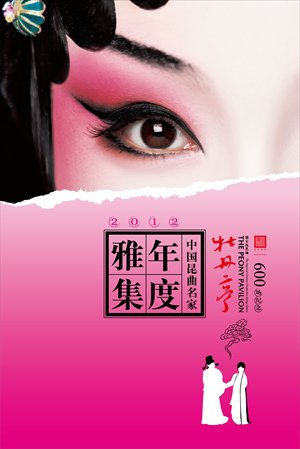
Photo: Courtesy of Imperial Granary
On stage, Du Liniang, the leading character in The Peony Pavilion by Chinese playwright Tang Xianzu (1550-1616), dies on a raining day. For dramatic effect, water falls from the ceiling into fish tanks surrounding the venue. The stage light trails Du, donned in white, as she walks through the arena to the back of the performance hall. The lights then suddenly shut off, as if Du's spirit has left the world. This breathtaking scene is from the Imperial Granary's rendition of The Peony Pavilion.
The Imperial Granary in Beijing was built in 1409 during the Ming Dynasty. (1368-1644). The well preserved venue now functions as a place for business meetings, fine dining and Kunqu Opera performances. The combination of traditional Chinese architecture and Chinese opera performances yielded successful results that made watching The Peony Pavilion at Imperial Granary a posh and fun activity.
With the stage play directed by Kunqu Opera master Wang Shiyu and the stage art designed by the renowned Lin Zhaohua, The Peony Pavilion has been continuously held over the last five years to packed audiences almost every Friday and Saturday.
To celebrate the staging of 600 performances, the show's production team will hold an event on November 17 and 18, inviting the industry's big names to attend a Kunqu Opera feast. "Most of the [invited performers] are over 70 years old. They represent the highest quality of Kunqu Opera in China. We hope this becomes an annual event for audiences to enjoy and appreciate Kunqu Opera," Wang Xiang, the producer of the show, wrote in an email to the Global Times.
Breakthrough style
Kunqu Opera is famous for its heavy literary lyrics, soft singing style, glamorous costumes and stage design. It has over 600 years of history and is known as the "ancestor of a hundred Chinese operas."
According to Cao Qijing, chief director of Kunqu Opera A Dream of Red Mansions, Peking Opera along with other regional operas have all inherited features from Kunqu Opera.
"Dance always accompanies singing. In Peking Opera, the performer may stand still to sing a long piece. But in Kunqu Opera, as soon as the performer starts to sing, he needs to move his body. This is a distinct feature of this art," said Cao.
He told the Global Times that Kunqu Opera faced extinction during the 1940s and 1950s, when many of the opera's biggest talents abandoned their professions for survival. It wasn't until 1956, when Fifteen Strings of Cash was made under the encouragement of the then premier, that the art saw a revival.
In 2001, Kunqu Opera became an UNESCO World Oral and Intangible Heritage, and people were reminded of the art's importance.
Pai Hsien-yung, a renowned writer from Taiwan, produced The Young Lover's Version of The Peony Pavilion in 2007. The show has toured around the world, receiving critical acclaim. The Imperial Granary's rendition, a recent version set outdoors in Shanghai, and A Dream of Red Mansions among other shows, have all revived the appeal of Kunqu Opera.
Contemporary audiences
At the Imperial Granary, subtitles for the lyrics and dialogue are displayed on screens in both English and Chinese. Some phrases are annotated.
Wang explained that literature is a main focus in this art form. The lyrics resemble poems from the Song Dynasty (960-1279). Without a background in literature, it might be difficult to understand. Subtitles thus guide contemporary audiences. The length of the stories was shortened to eight scenes, in a 90-minute performance.
With many productions coming out in recent years, necessary changes have been made in each production. Traditionally, Kunqu Opera follows a slow pace, unappealing to younger audiences. In A Dream of Red Mansions, stagnant scenes were taken out to suit a younger audience's tastes.
But Cao emphasized that the singing and music style are fundamentals of Kunqu Opera and should never be changed. According to Cao, artists have different ideas when it comes to innovating a traditional art form. Some may be more conservative while others push boundaries. Regardless, both sides search for new possibilities in reviving the art.
Limitless art
Wang said that during the last century when Western dramas were dominated by realism and naturalism, Peking Opera performer Mei Lanfang's tour in the US and the former Soviet Union was seen as fresh. With the development of various dramas in Western countries, a successful show resulted from the combination of multiple qualities, including performance, music, dance, stage design, costume design and props.
For Wang, the decline of traditional Chinese opera is not due to an unsupportive audinece base. High quality art survives, as art is a universal language. After taking his show abroad, Wang's found that there were always teary audience members at the end of the show.
"Art speaks to the heart. Beneath the glorious stage design and costume, the content must touch audiences," said Wang.
Xu Chunlan, the director of Kunqu Opera A Dream of Red Mansions, told Global Times that she has similar experiences of receiving appreciation in foreign countries.
Although the number of Kunqu Opera fans is growing, there is a limited number of young people who want to work in this field. Xu said the financial kickback for Kunqu Opera performers is low. In a competitive performing market, the future development and preservation of this precious art needs increased financial backing and support from society.

Copyright ©1999-2011 Chinanews.com. All rights reserved.
Reproduction in whole or in part without permission is prohibited.